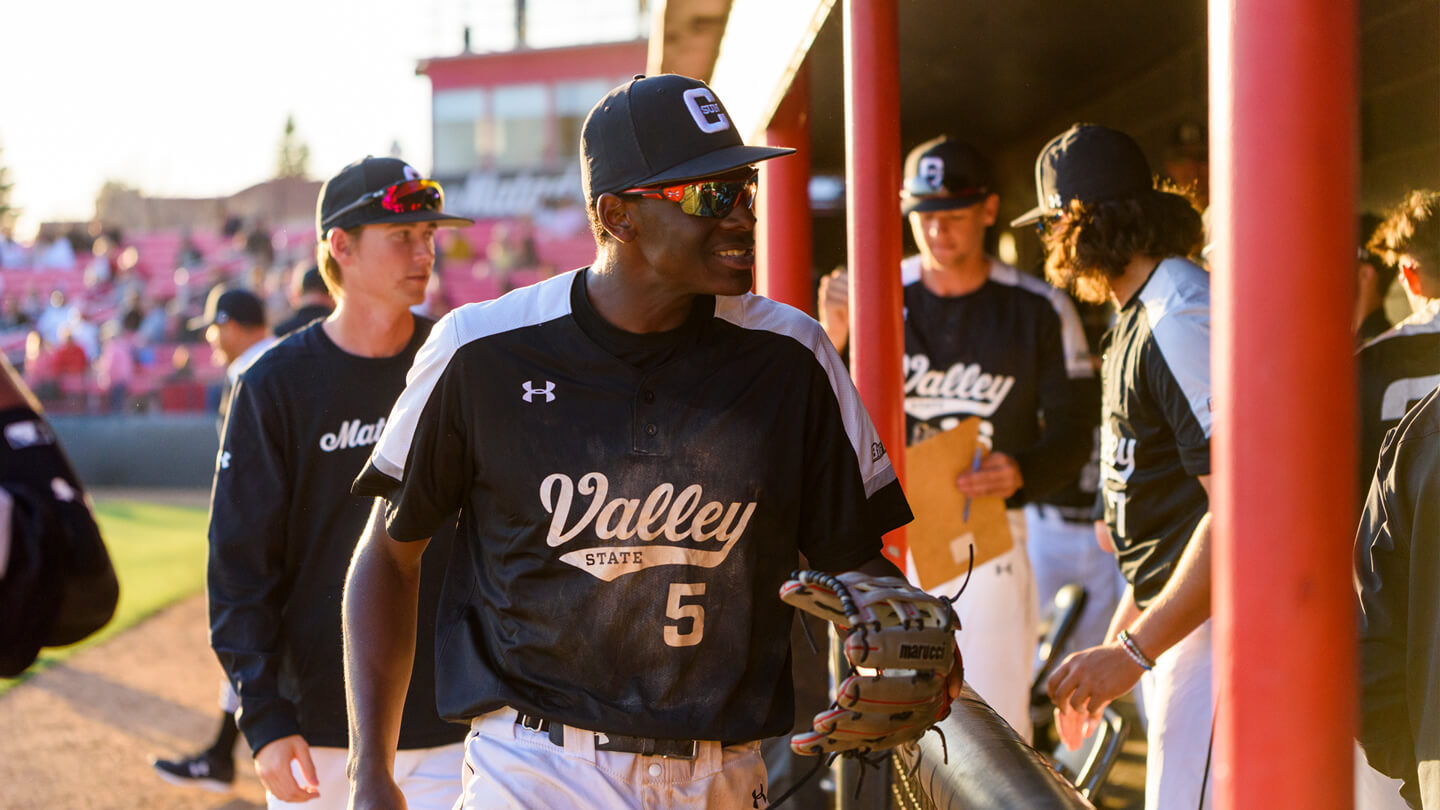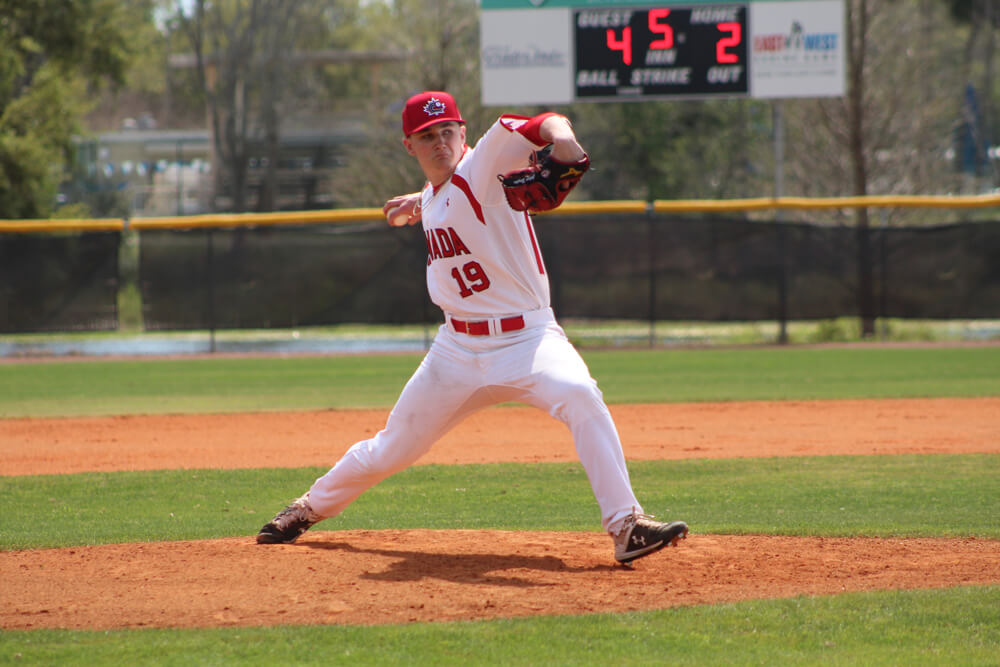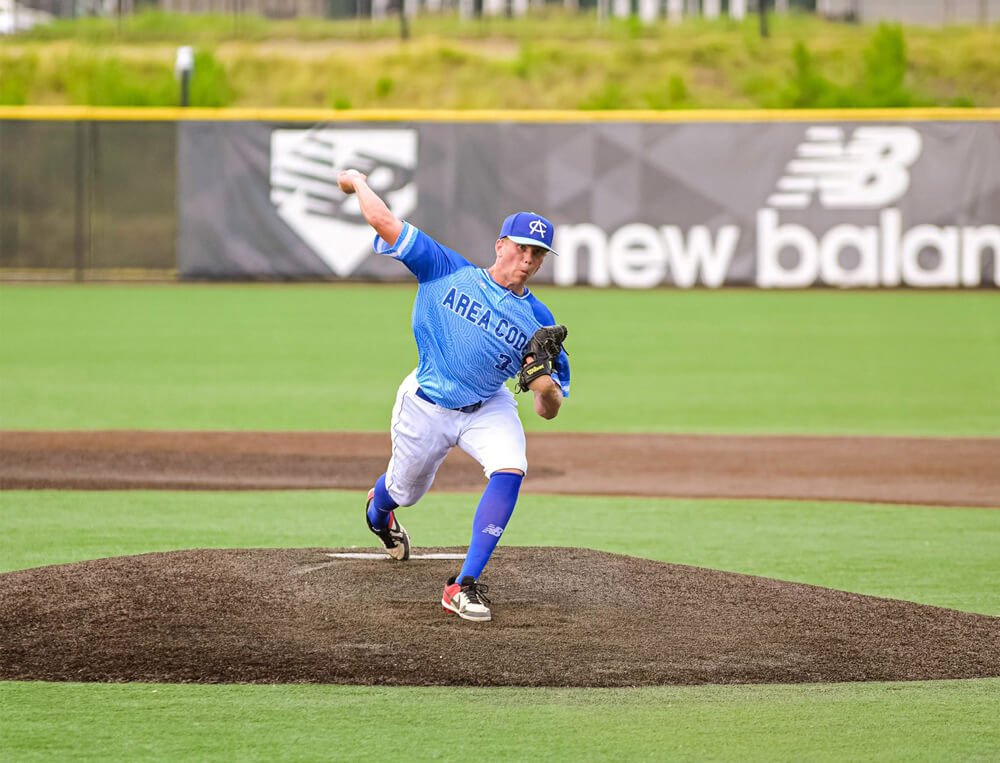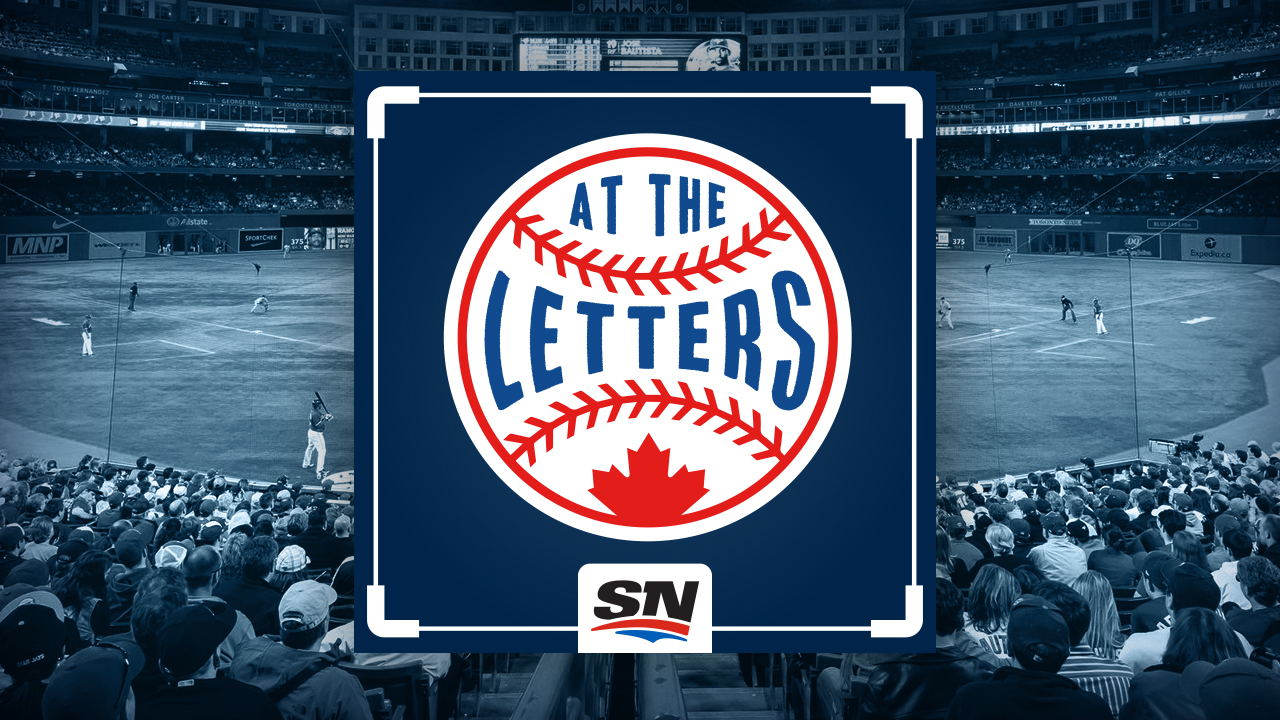Word spread through the Matador Stadium dugout at the end of practice, as Canadian outfielder Denzel Clarke sat unwinding with some of his California State University Northridge teammates. They were preparing for a weekend series with the University of Iowa but had been hearing that the Hawkeyes weren’t going to travel amid deepening concerns about COVID-19. That day, March 12, Major League Baseball followed the NBA’s lead and suspended spring training ahead of looming lockdowns. The Big West Conference, home of Clarke’s Matadors, followed suit, which meant CSUN’s just completed workout would be the group’s last for the foreseeable future. “We were like, ‘Wait, what?’” recalls Clarke, who was in the midst of a breakout sophomore season. “It was really crazy. I didn’t know what I was going to do at the time, to be honest.”
Clarke ended up scrambling home to Pickering, Ont., and the 20-year-old hasn’t been back on the field with the Matadors since. When play will resume is still unclear, which for someone like Clarke, who had been elevating his stock for the 2021 MLB Draft, is far from ideal — and being Canadian has only made things more complicated. For Clarke and other eligible players from north of the border, the pandemic first disrupted their seasons and the growth opportunities that can only come on the field, and then made getting crucial exposure to influential evaluators difficult, and at times impossible.
Even with the draft pushed back a month to July and vaccine approvals raising hopes of seeing some steps toward normality by the time spring arrives, Canadians will still be lagging behind their American counterparts. Right-hander Calvin Ziegler of Heidelberg, Ont., was eligible to be chosen in the five-round draft this past summer, but went unselected because, “most of the scouts said they just didn’t have enough on me,” he says. With plans to re-enter the 2021 draft, Ziegler made a pair of forays down south to pitch in four showcase events, each trip requiring a 14-day quarantine upon return, which meant pausing his throwing program for two weeks afterwards. Left-hander Mitch Bratt of Newmarket, Ont., didn’t want to go through the same process, so he ventured south for a pair of October showcases on a single trip to wrap up his season. “I felt like because I was shutting down my arm when I came home it was a good time, and I could do all my stuff for school online,” he says. Righty Micah Bucknam of Abbotsford, B.C., meanwhile, had just secured his Canadian citizenship at the beginning of the year and was set to join the junior national team. Instead he managed to pitch at one showcase in the United States for which he hastily ramped up his arm. “Every little chance you get,” he says, “it’s just, make the most of it.”
For Canadian players heading into the 2021 draft, there’s no mantra more fitting.

Initially, Clarke wasn’t sure what to do after the shutdown was imposed. There was no sense of how long the season’s suspension might last and Los Angeles is a long way from home, so there wasn’t much urgency to head north. Then the federal government recommended that Canadians abroad return home while commercial transportation was still available, and Clarke decided he better get back before border closures made it impossible. “I had to leave within like a week,” he says. “I packed everything, made sure everything was taken care of back in California on the school front, with friends and family, too, take care of the apartment stuff.”
Clarke and the teammates with whom he shared a place steps from campus managed to escape their lease and parted ways. Upon returning home to Pickering, he tentatively re-entered the house, afraid he might have been carrying the virus, wary of possibly transmitting it to his mother Donna, a former Canadian Olympic heptathlete, and the rest of his family. “I threw all my clothes in the washer and went to take a shower before I gave them a hug,” he says.
During his two-week quarantine, Clarke tried to imagine what his summer could look like. He had hoped to pick things up where he’d left off with the Matadors after batting .400/.529/.775 with three homers and five steals through his first 15 games. When that fell off the table, he wondered about playing summer ball. That didn’t happen either. “It’s almost like everything just kept getting worse and piling on,” he says. “You had to find a way to keep in baseball shape and try to stay optimistic and positive.”
From the moment his quarantine ended, Clarke started running at a local field with his mom, who trains athletes at the Quest Sports Track and Field Club she helped found. He brought a set of her weights home to use in workouts. Once gyms reopened, he got on a four-times-a-week program, and at least three times a week he worked on his sprinting with his mother. He also tried to hit and throw every day, initially with the aim of being ready for summer ball, and later for the fall season. After both were shut down, Clarke worked with Glenn Jackson, a coach from his club team days with the Toronto Mets, and got in live at-bats with other local players from American junior colleges and Div. 1 schools. “Some of the guys I didn’t know too well, some I got to know a little better and some of them are my homies from high school,” says Clarke. “It was really awesome, getting to be with those guys and seeing familiar faces after seeing only your family.”
Despite the limited opportunities and fewer looks from scouts, D1Baseball still listed Clarke at No. 82 in its 2021 College Top 100 rankings in early December. He’s hoping for a proper spring season that will allow him to reconnect with teammates, meet the freshmen he’s only interacted with online and test the physical gains he’s made throughout the pandemic. “I’ve really been able to work on my strength and speed and my overall game,” he says. “That has really translated to power, arm strength and overall baseball development, as well. I’ve really seen jumps in all facets of my game and I’m really excited to see how it plays out this spring season.”

Pitchers Bratt and Ziegler first heard about Major League Baseball’s shutdown as their national junior squad was on the field March 12 for the annual spring training exhibition against the Toronto Blue Jays. The spring tour is the first of three pivotal showcase events for the Canadian juniors every year, followed by trips to extended spring training and the Dominican Republic. MLB’s closure brought a premature end to that schedule and they returned home unsure what would happen next.
Once he got home, figuring the pandemic was going to keep everything closed down for an extended period, Bratt decided to build a mound. The lefty stacked a pair of old bunk-bed frames and then used a pair of tires to create slope. With roughly 70 feet of backyard to work with, he was able to set up a net at the far end, and for two months that was his catcher. By May, the makeshift mound had broken down just as local diamonds reopened. He and his father would head to a ballpark and set up in the bullpen. There, Bratt would toss a bucket of balls into a net, which his dad dutifully emptied. Soon that gave way to workouts at an Aurora diamond with some of his Toronto Mets teammates, with live at-bats every Friday. Some Mets alumni in the area began coming out, too, “so it was better competition, more intense at-bats, which was great to keep up the compete level.”
A limited schedule of games against two other clubs began in July, but the exposure was minimal, which made August invitations to the East Coast Pro Showcase in Hoover, Ala., and the Area Code Games in Emerson, Ga., all the more appealing. There was also a college scholarship to think about; Bratt had verbally committed to Florida State University in September 2019, but nothing was set in stone. Despite that, he took a pass on both events, “a family decision not to go because of the 14-day isolation rule and other factors,” he explains.
The cancellation of T12, the Blue Jays’ heavily scouted annual showcase event at Rogers Centre, made that decision tougher, but an all-star tournament Sept. 25-27 hosted by the Canadian Premier Baseball League offered one chance to get seen. But because the border remained closed, only 10 Canadian-based scouts managed to attend, which prompted Bratt to travel for a pair of events in October, The Baseball Factory All-Star Classic in Frisco, Tex., and Perfect Game’s World Wood Bat Association tournament in Fort Myers, Fla.
The pressure to avoid gaps between his looks down south “did play a part” in the decision, Bratt says. “T12 is usually a big staple for getting your name out there as a Canadian. And then with the Mets, the high-exposure events that we were supposed to go to in the summer, we weren’t able to travel at all, which sucked. But going on those two trips to Texas and to Florida really helped me get my name out there a little bit, just because American scouts hadn’t seen me in a while.”
The solid performances there helped lock up his scholarship to Florida State — Bratt signed his letter of intent Nov. 11 — and ease some of his concerns about how the loss of competition might impact him. Instead of throwing the 60-70 innings he would log in a typical summer, he figures he threw 20-25, but like Clarke, he made physical gains by working out as much as he could. He also regularly sent video to Paul Spoljaric, his Mets pitching coach, for guidance on mechanics and arm maintenance. Bratt worked through his weighted ball program by throwing against his house, “which my parents weren’t too happy with, but we had to suck it up a little bit. … With the shutdown, I wanted to improve and get better, I didn’t want to come out the same player as I was before.”
Bratt’s hope is that the spring brings more opportunities to put those gains on display. The junior team is aiming for a trip to Florida and the showcase circuit is sure to create some options to fill demand. Whether that’s enough to properly set him up for the 2021 draft is unclear, but having the Florida State scholarship gives him a strong backup plan.
“I feel like I definitely have put myself in a better situation than I was in a few months ago for the draft,” adds Bratt. “But attending more of those events, if possible, getting in front of the right scouts and just getting a good rep and a good word out for myself — that can go a long way.”

Ziegler had even less structure than Bratt when he first arrived home from the junior team’s Florida trip. He followed up his 14-day quarantine with steady work in his home gym, but minimal pitching because there was no one around who could handle him. “I was throwing to my dad and it’s not really the same intensity,” he says. “I couldn’t really throw any off-speed because, no offence to my dad, but his reactions aren’t exactly primed anymore.”
Given that Ziegler was sitting 91-93 m.p.h. and touched 94 in Florida, it’s hard to blame his dad for not being quite up to snuff. But being unable to really pitch made for a tedious stretch, alleviated only somewhat by the Great Lakes Canadians, his club team, running regular check-ins and Zoom calls with nutritionists and other experts to avoid wasting the down time.
When restrictions loosened in the middle of May, Ziegler was playing catch-up on the mound. He felt stronger from his workouts, but actually throwing to a catcher with a hitter in the batter’s box felt weird. So did the feel of the ball coming out of his hand. “I obviously wasn’t off a mound [until May]; I wasn’t wearing cleats. So I get back there, I’m [only] throwing mid-to-high 80s, and I was like, ‘What happened?’” he recalls. “Then you really look at it and I wasn’t actually throwing. So I was getting my body more prepared to throw hard again by lifting, but my arm wasn’t exactly doing the movement. Once we got back into things, it figured itself out.”
Did it ever. During a May 30 bullpen session, a Rapsodo tracker clocked Ziegler at 97.3.
97.3 MHP @GLCanadians @CDNBaseballNet @BaseballCANJNT @PBR_Ontario @PitchingNinja #MLBDraft pic.twitter.com/uBl3wCWfeZ
— Calvin Ziegler (@CalvinZiegler19) May 31, 2020
The heat wasn’t enough, though. Having only put in three innings with the junior team in the leadup to the 2020 draft, Ziegler’s body of work was simply too small for a team to commit to him, especially with the draft shortened to five rounds from the traditional 40. He wasn’t picked. He still had a scholarship to Connecticut for this fall, but with so much instability he opted instead to do an extra year of high school and reclassify for the 2021 draft. “Looking back on it now, I’m actually kind of happy it didn’t work out, just because this next year it’ll be better,” he says. “And obviously some of those guys who got drafted this year didn’t actually really get to do anything [in pro ball].”
To ensure it does turn out better next summer, Ziegler got as many looks as he could. Like Bratt, he only logged 25-30 innings, but he decided to attend the East Coast Pro and Area Code Games in early August, and then after his 14-day quarantine, built himself up again for early October’s The Baseball Factory and Perfect Game events, both of which helped solidify his standing and secure a scholarship to Auburn. A handful of major-league teams have held Zoom calls with him to track his progress, and he’s hoping to be included if the junior national team is able to travel south in the spring. “I feel like I did show myself pretty well with those big four events,” he says. “I obviously did progress a little bit from March, so I was showing a better version of myself, which I’m happy to say. I do feel a little bit more confident, but I obviously still want to show myself a couple of times before the draft in the new year. We’ll see how that goes.”
Ben Nicholson-Smith and Arden Zwelling host the most in-depth Blue Jays podcast in the league, covering off all the latest news with opinion and analysis, as well as interviews with other insiders and team members.
After his expected debut with the junior national team got pushed back by the pandemic, Bucknam — the righty from Abbotsford — is another player looking forward to the spring. He was unable make the March trip this year because his Canadian citizenship wasn’t finalized in time, and once it arrived the squad’s travel plans had been shelved. As a result, the downtime has been especially costly, robbing him of critical experiences and exposure. “I’ve had conversations with people [saying], ‘You’re really kind of hidden,’ and I’m like, ‘Yeah,’” he says. “It’s been hard with this whole quarantine thing, because there’s a lot of opportunity in the States.”
Bucknam was born in Milton, New Zealand, to parents from the Seattle area. Thirteen years ago, his family settled in Abbotsford, where his father is a pastor. Initially, they didn’t expect to stay in the border town long, “but it ended up becoming home to us,” he says. It was there he first picked up baseball, instantly showing an aptitude for the game. The parents of a close friend, Treyson Smith, knew the local baseball scene in a way Bucknam’s folks didn’t and helped steer him onto a more competitive path. He and Smith remain teammates to this day with the Fraser Valley Cardinals, a club team in the B.C. Premier Baseball League.
Not that they saw much of each other during the spring and early summer; teams in British Columbia weren’t able to resume full practices until early July. In-club play began at end of that month and games with cohort rivals started at the end of August. Bucknam spent the majority of the shutdown working alone, throwing sporadic bullpens into a net and, once restrictions began easing, to his Fraser Valley catcher Ryan Johnson once a week. “I’d throw a 40-pitch bullpen and then not throw the rest of the week, and do it again the next week,” he says.
The erratic throwing schedule made development a challenge, particularly when Bucknam secured a spot in the Area Code Games in early August. Unable to work with his coaches until July, “I was having to do a lot of things on my own,” he says. “Learning how to do that myself and do it safely without getting injured was kind of hard. You don’t know how often you’re supposed to throw and doing things a little wrong could result in issues down the road. I worked with my coach for like a week before I left. There were a couple of things that we needed to sort out — my mechanics were a little off — but for the most part it was good.”
A trip down south meant a 14-day quarantine upon his return, again interrupting his progress just as he started regaining a rhythm. But the trade-off of getting in front of scouts and competing at such a high level, even under sink-or-swim conditions, was worthwhile. “The experience was amazing,” Bucknam says. “I was really thankful to be able to go and throw in front of a bunch of scouts. The opportunity was really important.”
The two weeks off came just before Baseball B.C. launched its return to play, which included a few regional events in the province that drew a sprinkling of scouts. “I tried to make the most of it,” says Bucknam, who signed his commitment to the University of Washington in November. “I was 92, 93 [m.p.h.], which was really great for me. I thought, ‘When’s the next time I’m going to be able to throw in front of a bunch of people? Try to make the most of every opportunity and just and see what happens.’”

In one sense, the anxiety prospects feel over the lost spring and summer, is wholly justified: Sure, Canadian-based scouts still managed to keep tabs on local talent, but with minimal opportunities to show what they can do at critical compare-and-contrast events players generally turned in a far smaller body of work from which evaluators could draw conclusions. Apart from the showcase circuit, tournaments in the U.S., often provide good measuring sticks and the chance to catch the eye of scouts from other areas. With those cancelled, too, a key means of moving up draft boards was lost — something no one wants to see again this year. “The hope from scouts I’ve been talking to is for a quick-switch in the spring,” says Greg Hamilton, Baseball Canada’s director of national teams. “There’s going to be a huge demand for spring showcase events from players asking, ‘How do I get seen in March and April?’”
Of course, even if Canadians do get those looks in the spring, they’ll still face the challenge of transitioning from a winter of indoor facility work onto full fields in the bright sun, often playing against Americans who are outdoors year-round. And they’d be doing so coming off truncated seasons and limited game reps, which could make the jump all the more difficult. All that adversity will make it a daunting task to hit the ground running, but the way the situation is lining up may offer some positives, too.
One Canadian-based scout for an American League team believes the extra month before the draft could be crucial in leveling the playing field. He expects that late looks in May and early June will give Canadian players a chance to change perceptions by showing themselves once the rust is off. “All the summer and fall seasons do is get you on the dance floor,” he explains. “To get drafted, you have to have momentum through the spring in terms of performance and development.”
Owen Caissie of Burlington, Ont., is a prime example of that. Caissie ended up a second-round pick of the San Diego Padres, 45th overall, last summer after beginning the year on the fringes of the top 200. A key moment for him was his home run during that junior national team meeting with Blue Jays on March 12, sneaking in an impact swing moments before the shutdown. It’s fair to ask whether he would have been taken even earlier had he been able to keep showcasing himself, but it’s also fair to wonder if he would he have gone that high without the homer. As prospects look ahead to the 2021 draft, Caissie’s story is one that could offer plenty of hope.
Of course things were different this year — in baseball and in life. The AL scout estimated that he saw roughly half as many games as he would have during a normal summer, but says he filled the lost time by making extra phone calls to people he trusts, building up profiles on players. When he did get to the diamond, “you got to see the real kid as opposed to the showcase events, when you can get fooled by a snapshot in time.”
And some things weren’t so different: “It’s a jungle out there,” the scout adds, “but the good players will continue to advance.”
Talented Canadians caught in limbo are counting on it.




